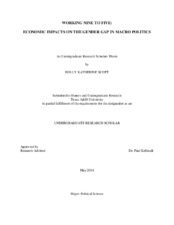| dc.description.abstract | A difference in aggregate public opinion and policy preferences between men and women has long been assumed but rarely fully empirically tested. In this analysis, I look at multiple economic factors impacting men and women in similar, yet different ways, which lead to a dynamic policy preference gap between genders. I test the impact of economic differences created by careers in “gender divisive,” or male dominated and non-male dominated industries on the differences between men and women’s policy preferences, created as a variation of Stimson’s Policy Mood. Through analysis, men are shown as more reactive to certain indicators, including self-professed macro partisanship and changes in inflation, while women are more reactive to fluctuations in job security in non-male dominated industries. This implies while men are more reactive to changes in cost and self-professed ideology, women become more liberal as their perceived likelihood of needing government support increases, leading to an overall gap in policy preferences due to different stimulants. | en |


